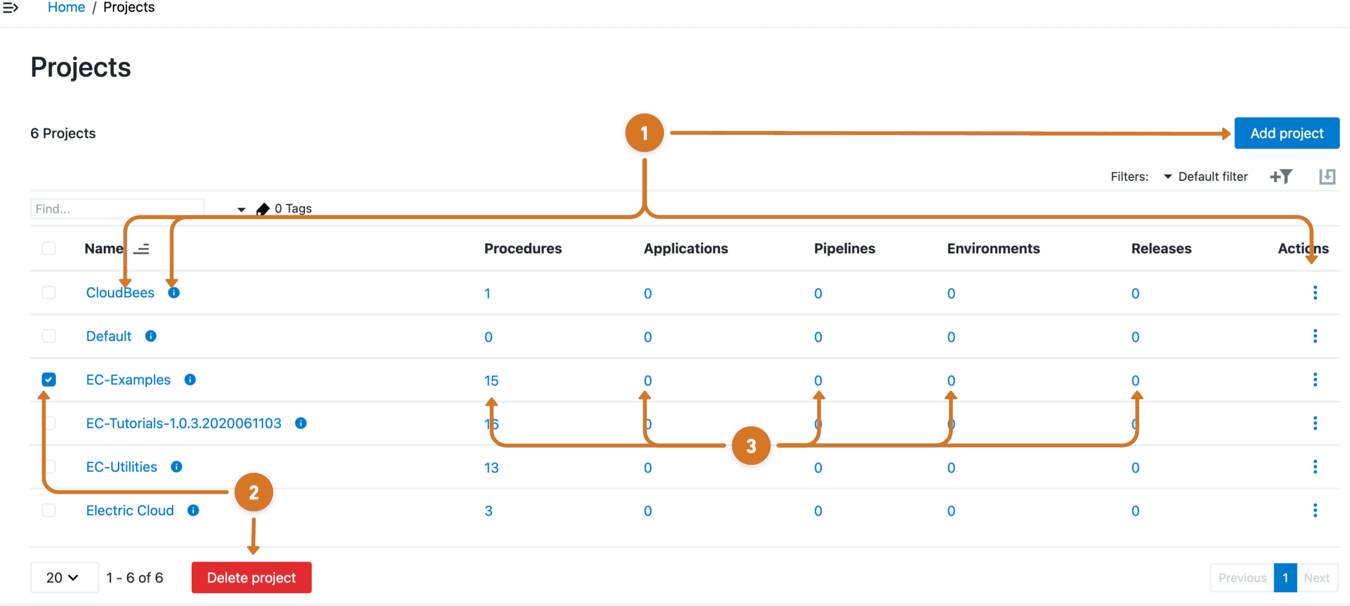A project is a top-level container within CloudBees CD/RO. Most information about software production processes, such as procedures, schedules, jobs, pipelines, releases, and workflows are contained within a project.
The projects UI is available from CloudBees CD/RO:
-
From the CloudBees navigation, select CloudBees CD/RO.
-
From the CloudBees CD/RO main menu, navigate to . The Projects list displays.
 Figure 1. The projects list
Figure 1. The projects list
You can perform the following actions:
-
Configure a project.
-
Create or copy a project by selecting Add project.
-
Modify project details by selecting the project Name link or
 information.
information. -
Select the
 three-dots menu to configure project attributes.
three-dots menu to configure project attributes.-
Modify the project name and description by selecting Details.
-
Select DSL Export to download the project in a DSL file.
-
Modify associated properties and property sheets by selecting Properties. For more information, refer to Configure properties or property sheets.
-
Specify explicit permissions for the project by selecting Access Control.
-
Review project revision data by selecting Change History.
-
Remove the project by selecting Delete.
-
-
-
Remove a project by:
-
Selecting the project checkbox.
-
Selecting Delete project.
-
-
Modify project procedures, applications, pipeline, environments, or releases by selecting the numeric link.
Creating a project
-
Select Add project. The New Project page displays.
-
Select either Create New or Copy Existing to create a new project from scratch or to copy another project, respectively. The respective dialog is displayed based on your choice.
-
If you are copying an existing project, select that project from the list. The next dialog box is prefilled with the settings from the copied project.
-
-
Enter information into the fields as follows:
Field Name Description Name
Enter a unique project name. Use a meaningful name such as a work group or product.
To avoid conflicts, do not use CloudBeesor any other CloudBees CD/RO-supplied project name. Also, theEC-prefix is reserved for CloudBees CD/RO-supplied project names.Description
(Optional) Plain text or HTML description for this object. If using HTML, you must surround your text with
<html> … </html>tags. Allowable HTML tags are<a>,<b>,<br>,<div>,<dl>,<font>,<i>,<li>,<ol>,<p>,<pre>,<span>,<style>,<table>,<tc>,<td>,<th>,<tr>, and<ul>.-
For example, the following HTML:
<p> <span style="font-family: Arial;"> <i>Note:</i> For more information about the <b>abc</b> object, see <a href="https://www.google.com/">https://www.google.com</a>. </span> </p>renders as follows:
<i>Note</i>: For more information about the <b>abc</b> object, see https://www.google.com.
Enable Change Tracking
Disable or enable change tracking for this project. This feature records every change between every state of non-runtime objects and lets you revert to an object’s prior state.
Tracked objects include traditional applications, microservice applications, procedures, workflows, workspaces, resources, pipelines, releases, and project-owned components such as library components. For more information, refer to Change Tracking.
Tags
(Optional) Object tagging provides a way to group related objects with a user-defined term. See Object Tags for further information.
Credentials
(Optional) Credentials and impersonations available to this project. For new projects, you are prompted to create project credentials on a subsequent dialog after project details are entered. Refer to Credentials and User Impersonation for further information.
Select Default Resource
(Optional) The default resource for all jobs that run under the project. This is a convenient way to use a single resource for an entire project.
You can specify resources in several other places such as in procedures, pipeline tasks, release tasks, and individual job steps. A resource specified elsewhere takes precedence.
Default resources specified here are not inherited by pipeline or release tasks. If you have not set up resource names or locations yet, refer to Create and manage resources for instructions.
Select Default Workspace
(Optional) Default workspace for all jobs that run under the project. This is a convenient way to use a single workspace for an entire project.
There are several other places where you can specify workspaces, such in as procedures, pipelines, releases, and individual job steps. A workspace specified elsewhere takes precedence.
If you have not set up workspace names or locations yet, refer to Define and use workspaces for more information.
-
-
Select OK. You are prompted to create or edit project credentials. If you choose Yes, the Credentials dialog displays. Your new project name displays on the project list page.
Editing a project
-
Select the action menu corresponding to the project that you want to edit and then select Details. The Edit Project dialog displays.
-
Update the information in the fields as needed. Refer to the table in Creating a project above for field descriptions.
-
Click OK to save your changes. Your changes display on the project list page.